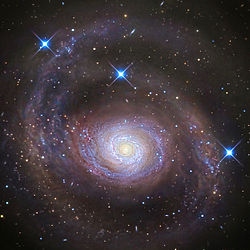Messier 94
| Galaxie Messier 94 / NGC 4736 | |
|---|---|
 | |
| Aufnahme mittels 0,9 m durchmessenden Teleskop des Kitt-Peak-Nationalobservatoriums | |
| AladinLite | |
| Sternbild | Jagdhunde |
| Position Äquinoktium: J2000.0, Epoche: J2000.0 | |
| Rektaszension | 12h 50m 53,0s [1] |
| Deklination | +41° 07′ 14″ [1] |
| Erscheinungsbild | |
| Morphologischer Typ | (R)SA(r)ab / Sy2 / LINER[1] |
| Helligkeit (visuell) | 8,1 mag[2] |
| Helligkeit (B-Band) | 8,9 mag[2] |
| Winkelausdehnung | 14,4/12,1[2] |
| Positionswinkel | 117°[2] |
| Flächenhelligkeit | 13,6 mag/arcmin²[2] |
| Physikalische Daten | |
| Zugehörigkeit | Canes-Venatici-I-Gruppe LGG 290[1][3] |
| Rotverschiebung | 0,001027 ± 0,000005[1] |
| Radialgeschwindigkeit | (308 ± 1) km/s[1] |
| Hubbledistanz H0 = 73 km/(s • Mpc) | (16 ± 1) · 106 Lj (4,93 ± 0,35) Mpc [1] |
| Durchmesser | 55.000 Lj |
| Geschichte | |
| Entdeckung | Pierre Méchain |
| Entdeckungsdatum | 22. März 1781 |
| Katalogbezeichnungen | |
| M 94 • NGC 4736 • UGC 7996 • PGC 43495 • CGCG 217-001 / 216-034 • MCG +07-26-058 • IRAS 12485+4123 • 2MASX J12505314+4107125 • GC 3258 • h 1456 • HIJASS J1250+41 • LDCE 867 NED128 | |
Messier 94 = NGC 4736 ist eine Spiralgalaxie vom Hubble-Typ Sab im Sternbild Jagdhunde am Nordsternhimmel. Sie ist schätzungsweise 16 Millionen Lichtjahre von der Milchstraße entfernt und hat einen Durchmesser von etwa 60.000 Lichtjahren.
Sie ist eine der hellsten Galaxien in der Canes-Venatici-I-Gruppe, einer Galaxiengruppe in der näheren Nachbarschaft der Lokalen Gruppe innerhalb des Virgo-Superhaufens.
Im selben Himmelsareal befinden sich u. a. die Galaxien IC 3795, IC 3808, IC 3835, IC 3842.
Eigenschaften
Es handelt sich um eine LINER-Galaxie, eine Form von AGN-Galaxien, deren Kernregion schwach ionisiertes Gas enthält.
Die Galaxie enthält zwei Ringe, von denen der innere durch eine sehr hohe Sternbildungsrate gekennzeichnet ist, die wiederum durch den Ausstoß von Gas aus dem Zentrum hervorgerufen wird. M94 wird daher auch als Starburstgalaxie klassifiziert und zählt zur Gruppe der Seyfert-Galaxien.
- GALEX-Gesamtaufnahme im ultravioletten Spektralbereich von Messier 94
- Infrarotaufnahme mittels des Spitzer-Weltraumteleskops
- (c) ESA/Hubble, CC BY 4.0Aufnahme des Zentrums mit dem Hubble-Weltraumteleskop, zu erkennen ist der umgebende Ring mit der hohen Sternentstehungsrate
- Überlagerung von Aufnahmen bei verschiedenen Wellenlängen
Entdeckung
Das Objekt wurde am 22. März 1781 von dem französischen Astronomen Pierre Méchain entdeckt.[4]
Literatur
- Michael König, Stefan Binnewies (2019): Bildatlas der Galaxien: Die Astrophysik hinter den Astrofotografien, Stuttgart: Kosmos, S. 332
Weblinks
- SIMBAD Astronomical Database
- astronews.com: Bild des Tages 20. Oktober 2015
- Starburst galaxy Messier 94 (engl.)
- Spektrum.de: Amateuraufnahmen [1][2]
Einzelnachweise
Auf dieser Seite verwendete Medien
Autor/Urheber: R Jay Gabany (Blackbird Obs.), Lizenz: CC BY-SA 3.0
Beautiful spiral galaxy M94 (Messier 94) lies a mere 15 million light-years distant in the northern constellation of the hunting dogs, Canes Venatici. A popular target for astronomers, the brighter inner part of the face-on galaxy is about 30,000 light-years across. Traditionally, deep images have been interpreted as showing M94's inner spiral region surrounded by a faint, broad ring of stars. But a new multi-wavelength investigation has revealed previously undetected spiral arms sweeping across the outskirts of the galaxy's disk, an outer disk actively engaged in star formation. At optical wavelengths, M94's outer spiral arms are followed in this remarkable discovery image, processed to enhance the outer disk structure. Background galaxies are visible through the faint outer arms, while the three spiky foreground stars are in our own Milky Way galaxy.
Bildtafel der 110 Messier-Objekte. Diese Datei wird in der w:de:Template:Navigationsleiste Messierobjekte als Imagemap genutzt. Sie darf daher nicht durch eine andere Version überschrieben werden!
Autor/Urheber: Credit:Hillary Mathis, N.A.Sharp/NOIRLab/NSF/AURA/, Lizenz: CC BY 4.0
M94, NGC 4736
The Sab spiral galaxy M94 in the constellation Canes Venatici is considered by some (but not others) to be in a group including M64 and various fainter galaxies. It has an extremely bright innner region surrounded by a blue ring of young star clusters, then a fainter yellowish region of older stars also surrounded by traces of young stars, and even further out a very much fainter outer ring. All of these features are visible in this picture, due to the use of a drastically compressed intensity mapping. This stretch also reveals quite a few small faint background galaxies. This picture was taken in May 1998 at the KPNO 0.9-meter telescope. Image size 17.0 arc minutes.
This image from NASA's Galaxy Evolution Explorer (GALEX) shows Messier 94, also known as NGC 4736, in ultraviolet light. It is located 17 million light-years away in the constellation Canes Venatici.
The spiral galaxy is punctuated by a distinct ring of stars at its center. The young stars glow with ultraviolet light and thus appear bright to the detectors of GALEX. Astronomers think the galaxy's oval shape may be the reason for this sharp ring of star formation. The ultraviolet light at the very center of the galaxy, within the ring, is likely produced by a combination of extremely old stars, about 10 billion years old.
GALEX highlights the complex star formation history in the outer arms as well. There, the blue-white regions highlight areas of current star formation, and the diffuse faint red light is from regions where star formation ceased more than 100 million years ago.(c) ESA/Hubble, CC BY 4.0
This image shows the galaxy Messier 94, which lies in the small northern constellation of the Hunting Dogs, about 16 million light-years away. Within the bright ring around Messier 94 new stars are forming at a high rate and many young, bright stars are present within it – thanks to this, this feature is called a starburst ring. The cause of this peculiarly shaped star-forming region is likely a pressure wave going outwards from the galactic centre, compressing the gas and dust in the outer region. The compression of material means the gas starts to collapse into denser clouds. Inside these dense clouds, gravity pulls the gas and dust together until temperature and pressure are high enough for stars to be born.
Name
Messier 94 • M94 • NGC 4736
Historically, Messier 94 was considered to have two strikingly different rings: a brilliant, compact band encircling the galaxy’s core, and a faint, broad, swath of stars falling outside its main disk.
Astronomers have recently discovered that the outer ring, seen here in the deep blue glow of starlight, may actually be more of an optical illusion. Their 2009 study combined infrared Spitzer observations with ultraviolet data from NASA’s Galaxy Evolution Explorer, and ground-based surveys in visible (Sloan Digital Sky Survey) and near infrared light (Two Micron All Sky Survey). This more complete picture of Messier 94 indicates that we are really seeing two separate spiral arms that, from our perspective, take on the appearance of a single, unbroken ring.
The bright inner ring of Messier 94 is very real, however. This area is sometimes identified as a “starburst ring” because of the frenetic pace of star formation in this confined area. Starbursts like this can often be triggered by gravitational encounters with other galaxies, but in this case may instead be caused by the galaxy’s oval shape.
Tucked in between the inner starburst ring and the outer ring-like arms we find the galaxy’s disk, striated with greenish filaments of dust. While, at first glance, these dusty arcs look like a collection of rings, they actually follow tightly wound spiral arcs.
Messier 94 is about 17 million light years away, making it a distant neighbor of our own Milky Way galaxy. It was first discovered by Charles Messier’s assistant, Pierre Méchain, in 1781 and was added to his supervisor’s famous catalog two days later.
Infrared light with wavelengths of 3.6 and 4.5 microns is shown as blue/cyan, showing primarily the glow from starlight. 8 micron light is rendered in green, and 24 micron emission is red, tracing the cooler and warmer components of dust, respectively. The observations were made in 2004, before Spitzer ran out of cryogen.
Type
Galaxy > Type > Spiral Galaxy > Type > Ring Galaxy > Activity > Starburst
Distance
16,000,000 Light Years
Redshift
0.001027
Color Mapping Band Wavelength Telescope Infrared 3.6 µm Spitzer IRAC Infrared 4.5 µm Spitzer IRAC Infrared 8.0 µm Spitzer IRAC Infrared 24.0 µm Spitzer MIPS
About the Color Mapping Table Astrometrics
Position (J2000)
RA = 12h 50m 53.1s Dec = 41° 7' 10.6"
Field of View
17.6 x 17.6 arcminutes
Orientation
North is 47.0° right of vertical
Constellation
Canes Venatici











